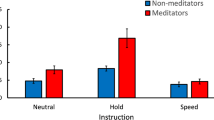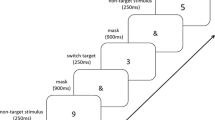Abstract
While many studies have shown that meditation enhances attentional processing, very few studies have investigated the effect of enhanced attentional processing on visual awareness. We investigate the attentional effects on visual awareness in focused attention meditators using a task that manipulates scope of attention using hierarchical letter stimuli (local and global processing) and single letter stimuli of varying size (small and large). In addition, working memory load was manipulated using a 0-back and 2-back task. Data were collected from Sahaj Samadhi Meditators and an age-matched control group of non-meditators. Visual awareness was tapped using negative color afterimages by measuring the duration and more importantly the clarity and color of afterimages using a rating scale. The afterimage durations were significantly longer for Sahaj Samadhi meditators compared to non-meditators. In addition, the afterimages were sharper for meditators compared to non-meditators suggesting that better attentional focusing associated with meditators might lead to phenomenal changes in visual awareness. Scope of attention influenced not only afterimage durations but also clarity indicating that changes in scope also influence aspects of visual awareness. The results indicate meditation training not only modifies attentional processes but also results in changes in conscious visual perception.






Similar content being viewed by others
References
Baars, B. J., & Franklin, S. (2003). How conscious experience and working memory interact. Trends in Cognitive Sciences, 7, 166–172.
Baijal, S., & Srinivasan, N. (2009). Types of attention matter for awareness: a study with color afterimages. Consciousness and Cognition, 18, 1039–1048.
Baijal, S., & Srinivasan, N. (2011). Consolidation of statistical information of multiple objects in working memory. Attention, Perception, & Psychophysics, 73, 1733–1741.
Brefczynski-Lewis, J. A., Lutz, A., Schaefer, H. S., Levinson, D. B., & Davidson, R. J. (2007). Neural correlates of attentional expertise in long-term meditation practitioners. Proceedings of the National Academy of Sciences, 104, 11483–11488.
Buttle, H. (2011). Attention and working memory in mindfulness. The Journal of mind and behaviour, 32(2), 123–134.
Carrasco, M. (2009). Cross-modal attention enhances perceived contrast. Proceedings of the National Academy of Sciences, 106(52), 22039–22040.
Carrasco, M. (2014). Spatial attention: Perceptual modulation. In S. Kastner & A. C. Nobre (Eds.), The Oxford Handbook of Attention (pp. 183–230). Oxford: Oxford University Press.
Carrasco, M., Ling, S., & Read, S. (2004). Attention alters appearance. Nature Neuroscience, 7, 308–313.
Carte, O. L., Prest, D. E., Callistemon, C., Ungerer, Y., Liu, G. B., & Pettigrew, J. D. (2005). Meditation alters perceptual rivalry in Tibetan Buddhist monks. Current Biology, 15(11), R412–413.
Chambers, R., Lo, B. C., & Allen, N. B. (2008). The impact of intensive mindfulness training on attentional control, cognitive style and affect. Cognitive Therapy and Research, 32, 303–322.
Chan, D., & Woollcott, M. (2007). Effects of levels of meditation experience on attentional focus: Is the efficiency of executive or orientation networks improved. Journal of Alternative and Complementary Medicine, 13(6), 651–657.
Chaudhuri, A. (1990). Modulation of the motion aftereffect by selective attention. Nature, 344, 60–62.
Chong, S. C., & Treisman, A. (2005). Attentional spread in the statistical processing of visual displays. Perception and Psychophysics, 67, 1–13.
Cowan, N. (2005). Working memory capacity. New York and Hove: Psychology Press.
Dehaene, S., Changeux, J. P., Naccache, L., Sackur, J., & Sergent, C. (2006). Conscious, preconscious, and subliminal processing: a testable taxonomy. Trends in Cognitive Science, 10(5), 204–211.
Demeyere, N., Rzeskiewicz, A., Humphreys, K. A., & Humphreys, G. W. (2008). Automatic statistical processing of visual properties in simultanagnosia. Neuropsychologia, 46, 2861–2864.
Friese, M., Messner, C., & Schaffner, Y. (2012). Mindfulness meditation counteracts self-control depletion. Consciousness and Cognition, 21, 1016–1022.
Fuller, S., & Carrasco, M. (2006). Exogenous attention and color perception: Performance and appearance of saturation and hue. Vision Research, 46, 4032–4047.
Goldin, P. R., & Gross, J. J. (2010). Effects of mindfulness-based stress reduction (MBSR) on emotion regulation in social anxiety disorder. Emotion, 10(1), 83–91.
Hodgins, H. S., & Adairs, K. C. (2010). Attentional processes and meditation. Consciousness and Cognition, 19, 872–878.
Jha, A. P., Krompinger, J., & Baime, M. J. (2007). Mindfulness training modifies subsystems of attention. Cognitive, Affective, & Behavioral Neuroscience, 7, 109–119.
Jha, A., Stanley, E. A., Kiyonaga, A., & Wong, L. (2010). Examining the protective effects of mindfulness training on working memory capacity and affective experience. Emotion, 10(1), 54–64.
Kemeny, M. E., Foltz, C., Cavanagh, J. F., Cullen, M., Giese-Davis, J., Jennings, P., & Ekman, P. (2012). Contemplative/emotion training reduces negative emotional behavior. Emotion, 12, 338–350.
Kirschfield, K. (1999). Afterimages: a tool for defining the neural correlate of visual consciousness. Consciousness and Cognition, 8, 462–483.
Koch, C., & Tsuchiya, N. (2007). Attention and consciousness: Two distinct brain processes. Trends in Cognitive Sciences, 11, 16–22.
Lamme, V. (2003). Why visual attention and awareness are different. Trends in Cognitive Sciences, 7(1), 12–18.
Lavie, N. (2006). The role of perceptual load on visual awareness. Brain Research, 1080, 91–100.
Lou, L. (1999). Selective peripheral fading: Evidence for inhibitory sensory effect of attention. Perception, 28, 519–526.
Lou, L. (2001). Effects of voluntary attention on structured afterimages. Perception, 30, 1439–1448.
Lutz, A., Brefczynski-Lewis, J., Johnstone, T., & Davidson, R. J. (2008). Compassion meditation: Effects of meditative expertise. Plos One, e1897.
Lutz, A., Slagter, H. A., Rawlings, N. B., Francis, A. D., & Greischar, L. L. (2009). Mental training enhances attentional stability: Neural and behavioral evidence. The Journal of Neuroscience, 29(42), 13418–13427.
Mack, A., & Rock, I. (2001). Inattentional Blindness. Cambridge, Massachusetts: MIT Press.
MacLean, K. A., Ferrer, E., Aichele, S. R., Bridwell, D. A., Zanesco, A. P., Jacobs, T. L., & Saron, C. D. (2010). Intensive meditation training improves perceptual discrimination and sustained attention. Psychological Science, 21, 1–11.
Parkes, L., Lund, J., Angelucci, A., Solomon, J. A., & Morgan, M. (2001). Compulsory averaging of crowded orientation signals in human vision. Nature, 4, 739–744.
Posner, M. I. (1994). Attention: the mechanisms of consciousness. Proceedings of the National Academy of Sciences, 91(16), 7938–7403.
Prinzmetal, W., Nwachuku, I., Bodanski, L., Blumenfeld, L., & Shizimu, N. (1997). The phenomenology of attention. Consciousness and Cognition, 6, 372–412.
Prinzmetal, W., Amiri, H., Allen, K., & Edwards, T. (1998). The phenomenology of attention Part 1: Color, location, orientation and spatial frequency. Journal of Experimental Psychology. Human Performance and Perception, 24, 1–22.
Raffone, A., & Srinivasan, N. (2010). The exploration of meditation in the neuroscience of attention and consciousness. Cognitive Processing, 11, 1–7.
Rensink, R. A. (2002). Change detection. Annual Review of Psychology, 53(1), 245–277.
Robins, C. J., Keng, S., Ekblad, A. G., & Brantley, J. G. (2012). Effects of mindfulness-based stress reduction on emotional experience and expression: a randomized controlled trial. Journal of Clinical Psychology, 68(1), 117–131.
Rose, D., Bradshaw, M. F., & Hibbard, P. B. (2003). Attention affects the stereoscopic depth aftereffect. Perception, 32, 635–640.
Slagter, H. A., Lutz, A., Greischar, L. L., Francis, A. D., Nieuwenhuis, S., Davis, J. M., et al. (2007). Mental training affects distribution of limited brain resources. PLOS Biology, e138.
Srinivasan, N., & Baijal, S. (2007). Concentrative meditation enhances pre-attentive processing: a mismatch negativity study. Neuroreport, 18, 1709–1712.
Suzuki, S., & Grabowecky, M. (2003). Attention during adaptation weakens negative afterimages. Journal of Experimental Psychology: Human Perception and Performance, 29, 793–807.
Tang, Y. Y., Ma, Y., Wang, J., Fan, Y., Feng, S., Lu, Q., & Posner, M. I. (2007). Short term meditation training improves attention and self regulation. Proceedings of the National Academy of Sciences, 104(43), 17152–17156.
Triesman, A. (2006). How deployment of attention determines what we see. Visual Cognition, 14, 411–443.
Tsuchiya, N., & Koch, C. (2005). Continuous flash suppression reduces negative afterimages. Nature Neuroscience, 8(8), 1096–1101.
Vugt, M., & Jha, A. (2011). Investigating the impact of mindfulness meditation training on working memory: a mathematical modeling approach. Cognitive, Affective, & Behavioral Neuroscience, 11, 344–353.
Wede, J., & Francis, G. (2007). Attentional effects on afterimages: Theory and data. Vision Research, 47, 2249–2258.
Zeidana, F., Johnson, S. K., Diamond, B. J., David, Z., & Goolkasian, P. (2010). Mindfulness meditation improves cognition: Evidence of brief mental training. Consciousness and Cognition, 19, 597–605.
Acknowledgments
This study was supported by a research grant (SR/CSI/27/2010) from the Department of Science and Technology, India. The authors thank the Art of Living Organization especially their teachers in Allahabad who agreed to participate in the study. The authors thank the two anonymous reviewers for their comments in improving the manuscript.
Author information
Authors and Affiliations
Corresponding author
Rights and permissions
About this article
Cite this article
Srinivasan, N., Singh, A. Concentrative Meditation Influences Visual Awareness: a Study with Color Afterimages. Mindfulness 8, 17–26 (2017). https://doi.org/10.1007/s12671-015-0428-1
Published:
Issue Date:
DOI: https://doi.org/10.1007/s12671-015-0428-1




